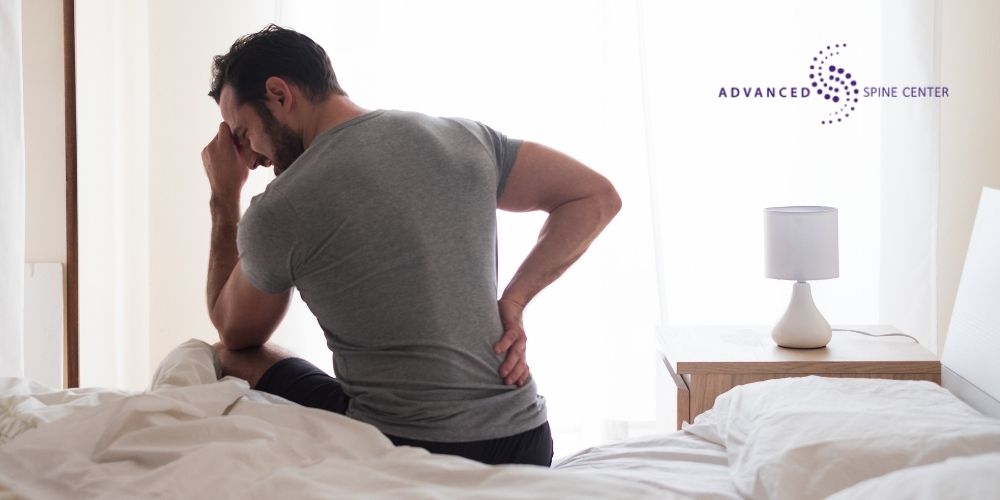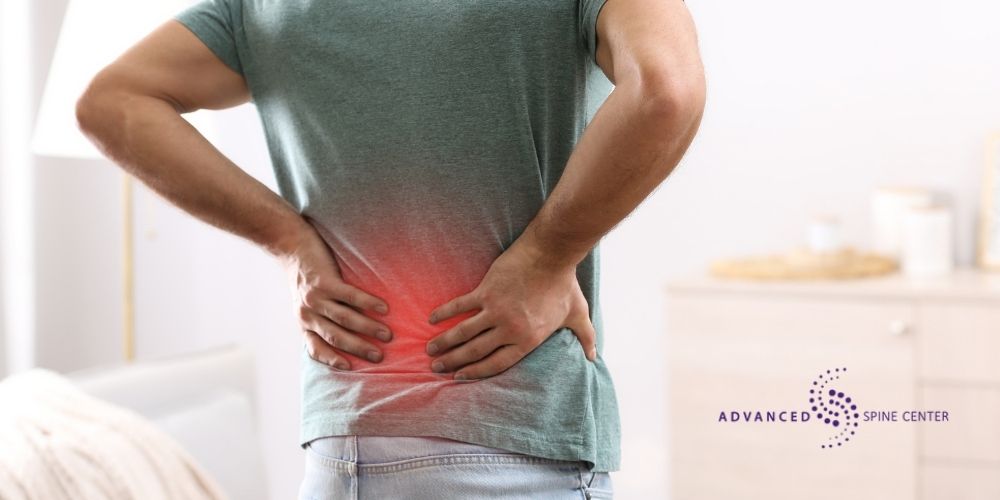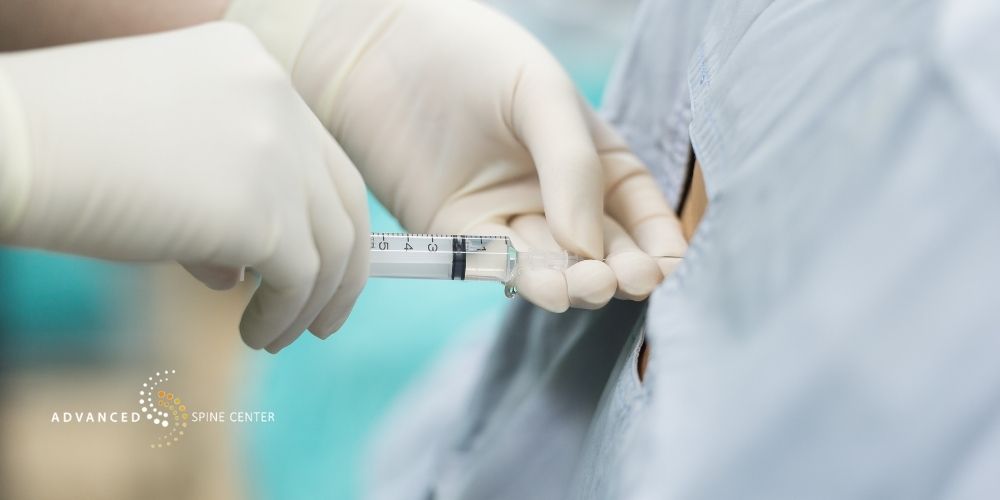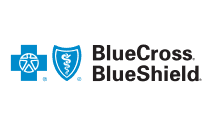Table of Contents
When you throw out your back, the pain can hit fast, sometimes with no warning at all. This sudden back injury often comes with sharp pain, stiffness, muscle spasms, and a limited range of motion that can make it hard to sit, stand, or even walk. Whether you’re feeling a dull ache or intense pain, getting the right treatment can reduce inflammation, improve mobility, and speed up the healing process.
Led by Dr. Stephen Courtney, The Advanced Spine Center in Plano, TX, has provided trusted back and spine care to patients in Texas for over 28 years. As a board-certified, fellowship-trained orthopedic spine surgeon, Dr. Courtney is dedicated to helping you recover and regain your quality of life. Call (972) 499-5457 or contact us online to start getting relief today.

What Does it Mean to Throw Your Back Out?
Throwing out your back usually means you’ve strained the back muscles or irritated the soft tissues in your lumbar region, often from lifting heavy objects, twisting the wrong way, or sudden movement. This type of injury can involve a muscle strain, ligament sprain, or inflammation in the affected area, causing sharp, sudden back pain, stiffness, and limited mobility.
Poor posture, repetitive physical activity, and degenerative spine conditions can increase the risk of throwing out your back. While some cases cause a mild dull ache, more severe injuries may lead to acute lower back pain, muscle spasms, and difficulty returning to normal posture.
What Part of the Back Is Usually Affected?
A thrown-out back most often affects the lower back, also known as the lumbar region. This area of the spine carries most of your body’s weight and is heavily involved in bending, lifting, and twisting, which makes it prone to injury.
The lumbar region is made up of back muscles, ligaments, intervertebral discs, and facet joints, all of which can be affected by a back injury. Muscle strain from overuse or twisting the wrong way is one of the most common causes of sudden lower back pain. Ligament sprains can also occur if the tissue is overstretched or torn. In more serious cases, a bulging or herniated disc can increase pain intensity and limit your ability to move. Facet joints in the spine can also become irritated or inflamed, especially when there’s spinal misalignment.
While upper and mid-back pain can happen, these areas are more stable and less likely to be injured. Most cases of acute back pain involve the lumbar region and require proper care to reduce pain, prevent stiffness, and promote healing.

Steps to Take After Throwing Out Your Back
If you’ve thrown out your back, knowing what to do next can make a big difference in how quickly you feel better. The steps below explain simple things you can do at home, and when it may be time to seek medical care. From using cold packs to avoiding movements that cause pain, each step helps to reduce discomfort and prevent more serious problems.
Stop and Rest
As soon as you feel sudden lower back pain, stop what you’re doing and rest. Trying to push through sharp pain or continuing physical activity can make the back injury worse. Resting gives your back muscles and tissues a chance to begin healing. Avoid movements like twisting, bending, or heavy lifting, especially during the first few days.
Apply Ice or Heat
Cold packs are most helpful in the first 24 to 48 hours after a back injury. Applying ice to the affected area for short periods can slow swelling and calm muscle spasms. After the first couple of days, start applying heat with a warm compress or heating pad. Heat can relax tight back muscles and improve blood flow around the injured area. It can also make gentle stretching easier and reduce stiffness after long periods of rest.
Use Over-the-Counter Pain Relief
Over-the-counter medications like ibuprofen or naproxen may help reduce inflammation and relieve pain after throwing out your back. They can make it easier to rest and begin light movement, but they should be taken only as directed. Relying on pain relief medications for too long can sometimes mask serious symptoms, so it’s important to monitor your pain intensity. If over-the-counter medications are not helping or you continue to feel pain after a few weeks, it may be time to seek medical care.
Gentle Movement and Stretching
While rest is necessary at first, staying in bed for long periods can actually slow the healing process. Staying active with gentle movements can promote blood flow, prevent stiffness, and help your back muscles begin to recover. Light stretching may also reduce pain and improve mobility, but only if it doesn’t cause discomfort. Always move carefully, avoid bending or twisting awkwardly, and gradually increase physical activity as your back begins to heal.

When to Seek Medical Care for a Back Injury
Many cases of a thrown-out back improve with rest and home treatment, but some symptoms can indicate a more serious back injury that requires medical attention. You should seek medical care if you have the following symptoms:
- Back pain that persists or gets worse after a few days
- Sudden sharp pain that radiates into your legs
- Numbness or tingling in the affected area
- Trouble standing, walking, or controlling your bladder or bowels
These signs may indicate a more serious back injury, such as a herniated disc, severe muscle strain, or damage to the spine and surrounding back tissues.
At Advanced Spine Center in Plano, TX, we use imaging tools like X-rays or CT scans to identify the exact cause of your back injury. An accurate diagnosis allows us to create personalized treatment plans that reduce pain and improve your mobility.
Non-Surgical Treatment Options for Acute Lower Back Pain
For many people, acute pain in the lower back can improve without surgery. Our team commonly recommends the following treatments based on the severity of your symptoms and overall spine health.
Physical Therapy
Working with a physical therapist can help strengthen back muscles after an injury. A customized program may include gentle stretching, guided exercises, and posture training to relieve pressure on the lumbar region and promote proper alignment. Physical therapy also teaches you how to avoid movements that could worsen the injury and techniques for lifting heavy objects safely in the future.
Epidural Steroid Injections
If acute lower back pain does not improve with rest, over-the-counter medications, or even prescribed muscle relaxants, then lumbar epidural steroid injections may be recommended.
Lumbar injections deliver anti-inflammatory medication directly around the affected nerves and tissues in the lumbar region to reduce pain and swelling. This treatment can be beneficial when inflammation causes pain to spread into the legs or limits your ability to move comfortably.
While not a permanent solution, lumbar epidural steroid injections can provide significant pain relief and make it easier to participate in physical therapy.

Minimally Invasive Procedures for a Thrown Out Back
When conservative treatments aren’t enough to relieve pain, minimally invasive procedures may provide effective relief. These options target the specific source of pain to reduce inflammation, improve mobility, and support the healing process without the need for traditional surgery.
Nerve Blocks
A nerve block is a minimally invasive procedure that can help reduce pain by temporarily interrupting pain signals sent from the nerves to the brain. During the procedure, medication is injected near the affected nerves in the lumbar spine. This treatment can help minimize acute pain and reduce inflammation in the irritated nerves, allowing them to heal.
Facet Joint Injections
Facet joints are small joints in the spine that help with bending and twisting. After throwing out your back, the joints can become inflamed and cause sharp pain or stiffness in the lumbar region. Facet joint injections deliver anti-inflammatory drugs directly into the irritated joint to reduce pain and improve mobility.
Surgical Solutions for Lower Back Pain at Advanced Spine Center
Surgical options may be considered if your lower back pain persists after non-surgical treatment. At Advanced Spine Center in Plano, TX, we offer advanced procedures designed to target the source of your pain and restore normal function.
Discectomy
When a damaged or herniated disc in the spine causes lower back pain, a lumbar microdiscectomy can help provide relief. This minimally invasive procedure removes the portion of the disc that is pressing on nearby nerves, while leaving the healthy part intact. By taking pressure off the affected nerves, the surgery significantly reduces acute back pain.
Laminectomy
Laminectomy surgery involves removing a small section of bone called the lamina from the back of the spine. This procedure creates more space for the spinal cord and nerves, reducing pressure and improving mobility. A laminectomy is often recommended when spinal stenosis, disc problems, or ligament thickening cause persistent back pain, muscle spasms, or weakness in the legs.
Spinal Fusion
Lumbar fusion surgery can help when instability in the spine causes ongoing back pain or affects normal posture and movement. This procedure connects two or more vertebrae to strengthen the spine and reduce motion in the affected area. Spinal fusion surgery can be especially effective for degenerative spine conditions, recurrent disc issues, or severe injuries that do not respond to conservative treatment.
How to Prevent Future Back Injuries
Following these simple steps can help to protect your spine and reduce the risk of throwing out your back again.
- Use proper lifting techniques – Always lift with your knees bent, not your back. Keep the object close to your body and avoid twisting while lifting heavy objects.
- Strengthen your core – Strong abdominal muscles provide better support for your spine and reduce the risk of muscle strain.
- Make ergonomic adjustments – Set up your workspace and home environment to support your back. Consider using chairs and tools that encourage proper posture.
- Stretch and move regularly – Incorporate stretching and daily mobility exercises to prevent stiffness in the back and improve flexibility.
- Maintain a healthy weight – Reducing excess pressure on your spine lowers the risk of lumbar back pain.
Making small lifestyle changes and building healthy habits can keep your back muscles strong and improve flexibility, helping you avoid future injuries.

Struggling With Back Pain? Call Advanced Spine Center Today.
If you’re experiencing ongoing pain after throwing out your back, the team at Advanced Spine Center in Plano, TX, is here to help. Dr. Stephen Courtney, a board-certified and fellowship-trained orthopedic spine surgeon, offers advanced treatment options tailored to your needs, from minimally invasive treatment to advanced surgical procedures.
Don’t let lower back pain control your life. Call (972) 499‑5457 or contact us online to schedule your first appointment today.










